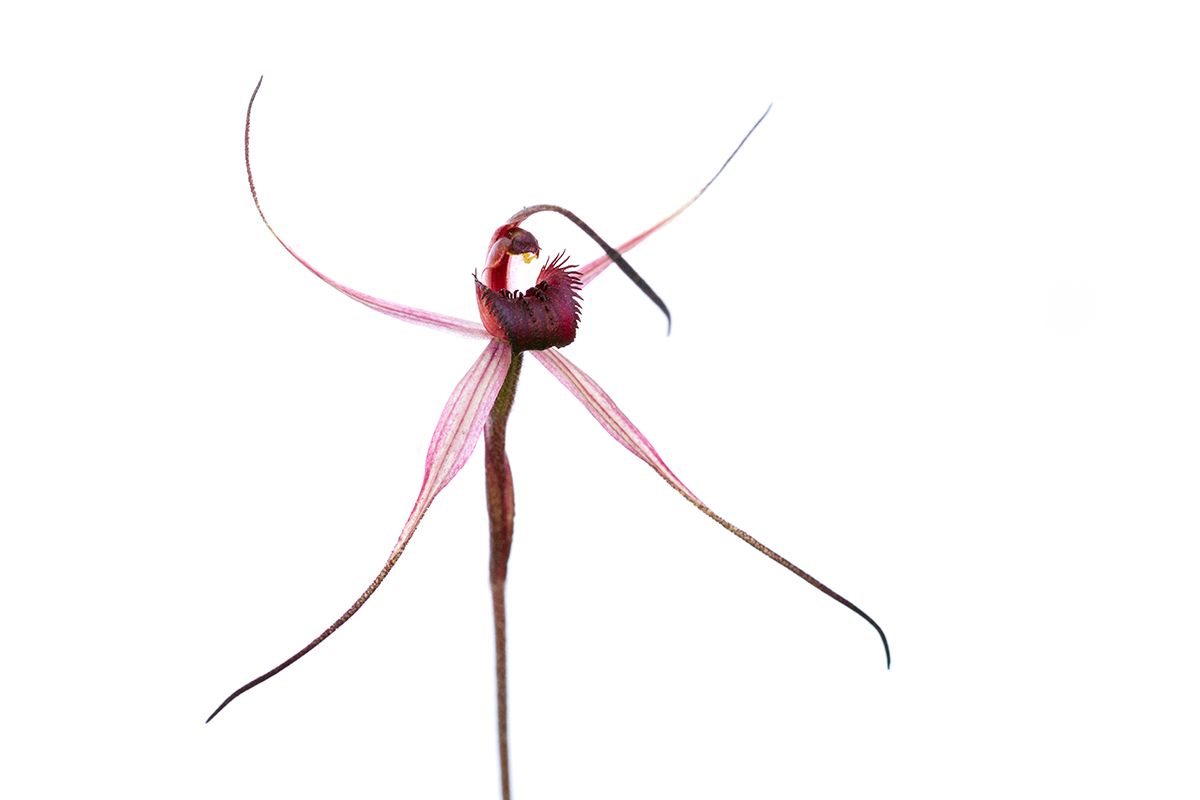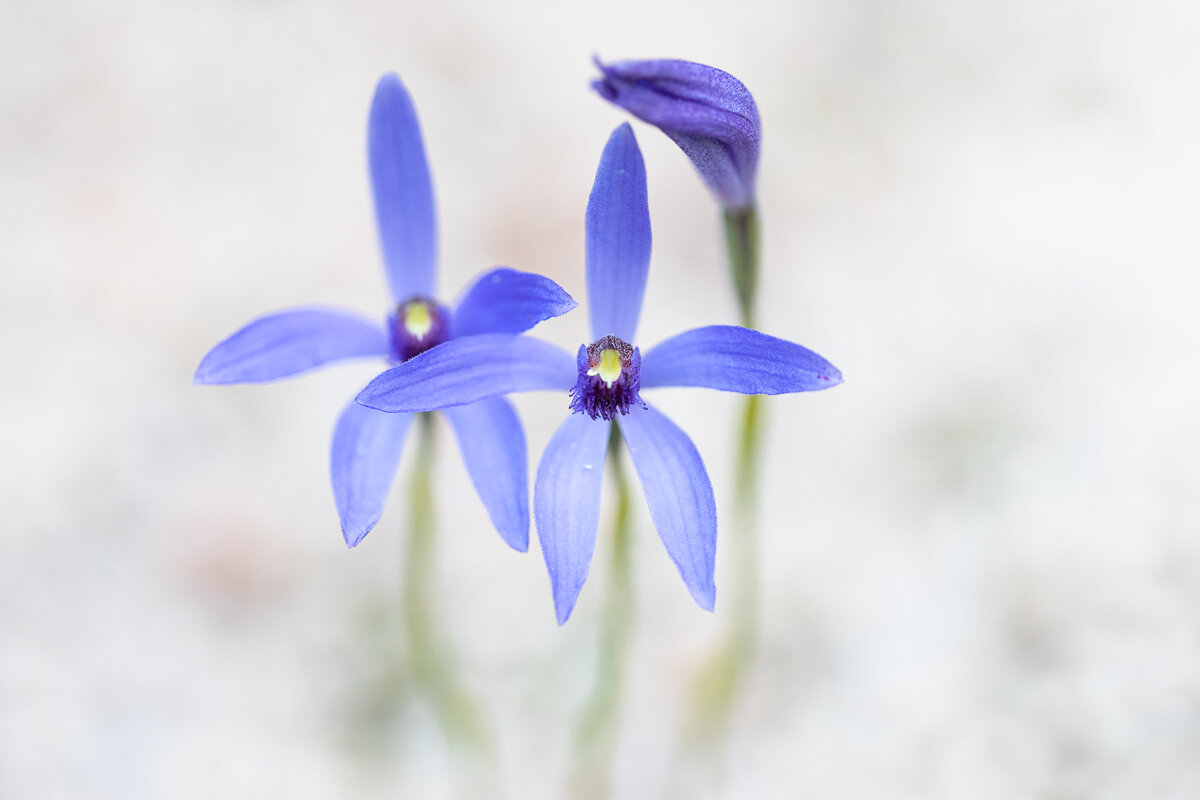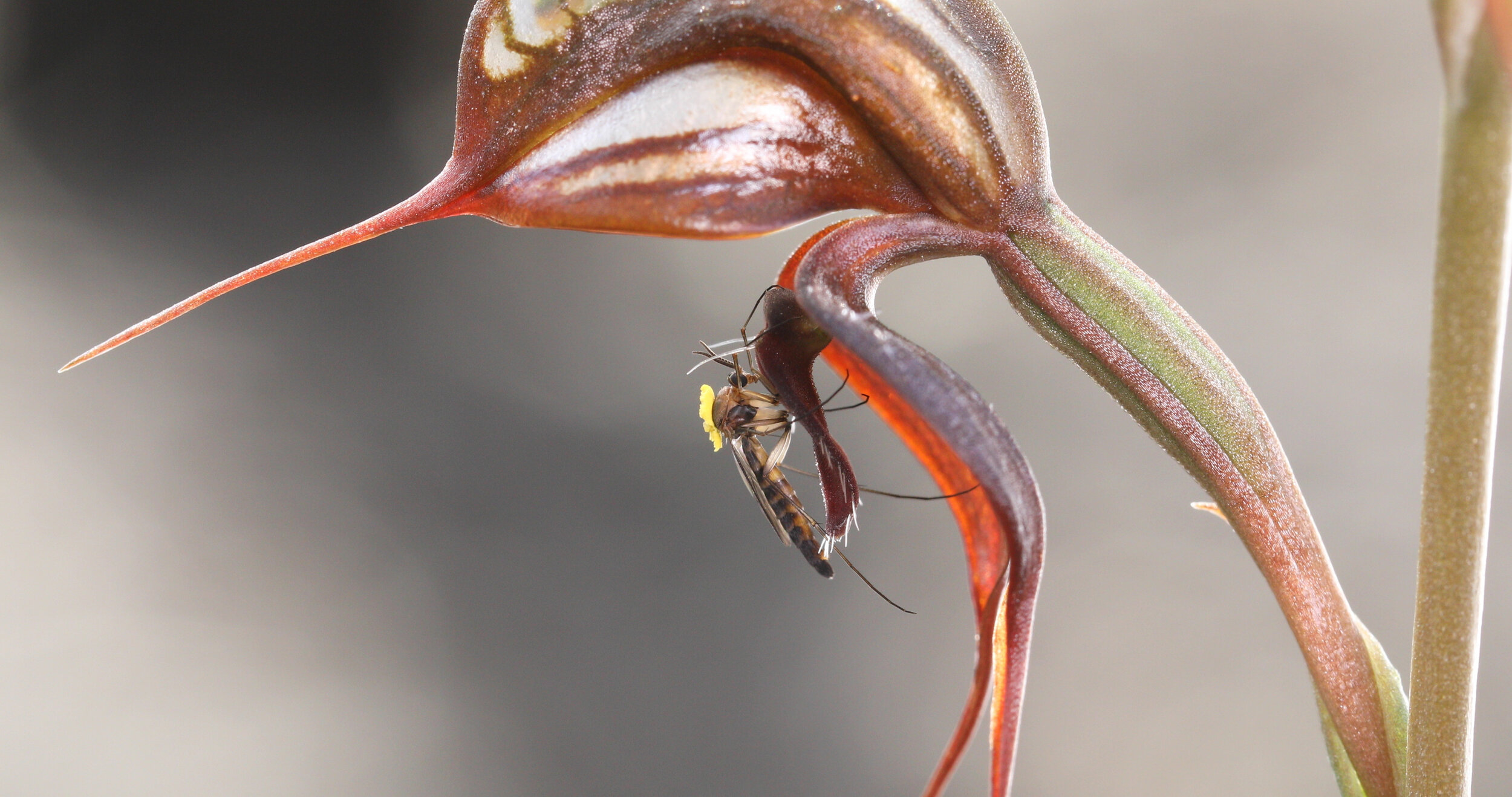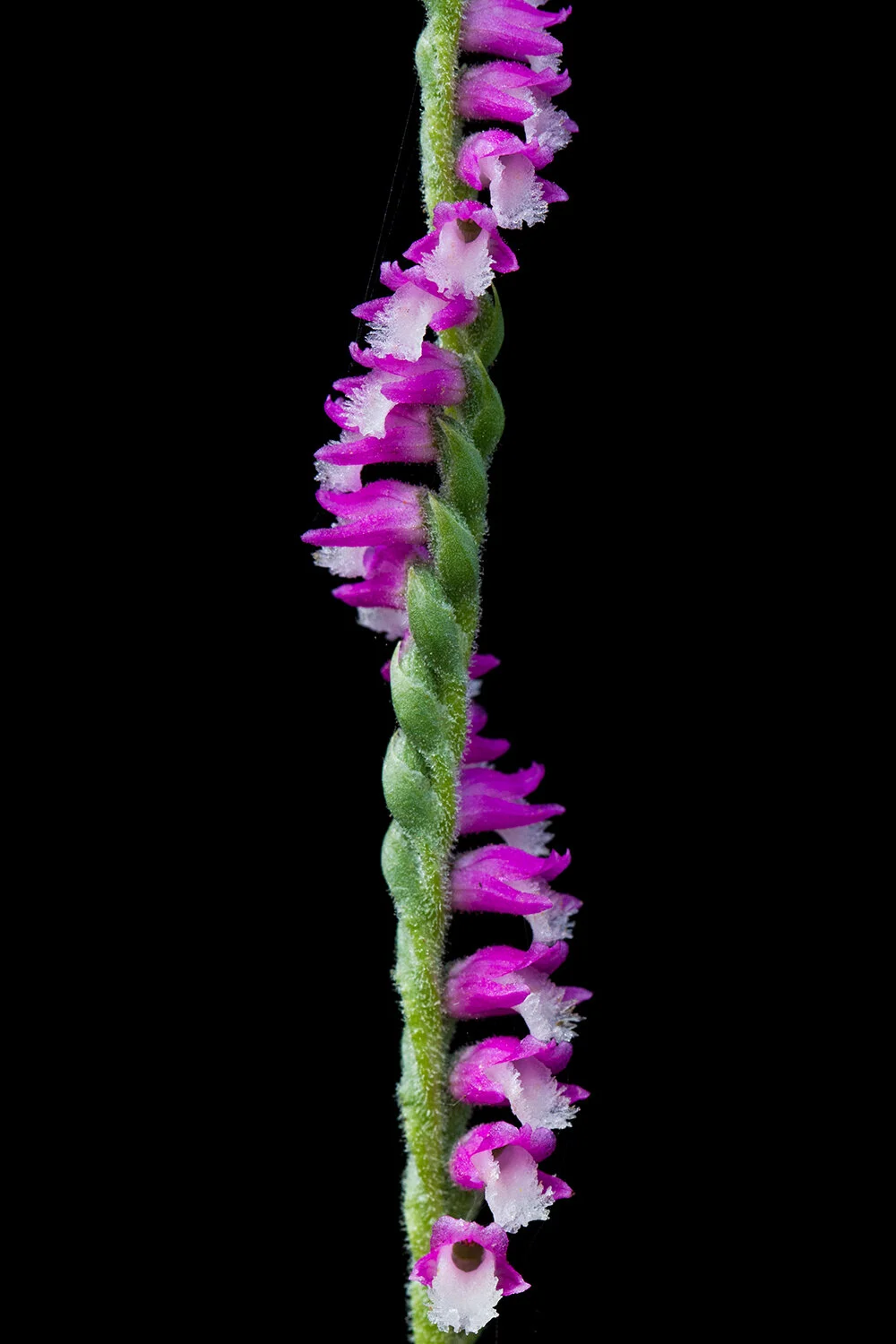Orchids have evolved some of the most extraordinary and unique shapes imaginable. It is almost hard to imagine that they are indeed flowers, such is the extent of their specialisation. Botanically, there are petals and sepals like any other flower, but they are so highly modified that they loose their definition in the shape of the flower as a whole. Many of these highly specialised modifications have arisen out of unusual pollination strategies, often closely linked to one or few specific insects. Here, in no particular order, I take a walk through some of the main groups of Australian terrestrial orchids.
Pterostylis grandiflora, the Cobra Greenhood - so named because of the brown, flared edges to its hood.
Caladenia, the spider orchids
Spider orchids are a group of several hundred species of terrestrial orchids, all endemic to Australia. There are many different types of Caladenia orchids, but here I focus on one group, the spider orchids. Many spider orchids have a close relationship to thynnine wasps - in most cases it is one species of orchid pollinated exclusively by males of only one species of wasp. The orchid attracts the male wasps through chemical cues that mimic female wasp pheromones. The male is thereby duped into attempting to mate with the labellum, the central 'lip', which resembles the female wasp. The yellow pollen is positioned above the labellum, so that when the wasp tries to mate with the labellum it receives a package of pollen on its back. Becuase of their trickery, these orchids are known as 'sexually deceptive' - they lure the wasps with false promises of females and in return offer nothing.
Caladenia orestes, the Crimson Spider Orchid
Caladenia actensis, the critically endangered Canberra Spider Orchid, with its newly discovered pollinating wasp. More info here.
Caladenia phaeoclavia with mating thynnine wasp pollinator Lophocheilus anilitatus. Note the packets of pollen (=pollinia) have already been deposited on the thorax of the wasp.
Caladenia latifolia, the Pink Fairy orchid.
Caladenia deformis, the common and familiar Blue Beard orchid, is widespread throughout southern Australia.
Pterostylis, the greenhoods
Greenhoods come in many different shapes and sizes, but can they can broadly be separated into those with an open hood (top) and those with a more closed hood (bottom). Like the spider orchids, many species of greenhood are thought to achieve pollination through sexual deception of insects. Instead of attracting wasps, greenhoods attract fungus gnats, a type of small fly. One of the key features of greenhoods is that the labellum is highly touch sensitive. When the labellum is disturbed by a fly landing on it (or a human knocking it!) it flips upwards or backwards, trapping the gnat inside the hood of the orchid. From here, the poor insect must crawl through a narrow passage which is specially designed to take the insect past the pollen sacs. When the gnat finally escapes, it has often received some pollen on its back, which it can then transport to another flower.
My PhD at the Australian National University focused on the pollination of greenhoods. You can read more about their fascinating pollination here.
Pterostylis (Bunochilus) tunstallii, commonly known as Tunstall's Leafy Greenhood.
Pterostylis (Oligochaetochilus) boormanii, known as Baggy Britches or Sikh's Whiskers.
The threatened orchid Pterostylis (Oligochaetochilus) cheraphila from western Victoria, and its pollinator Xenoplatyura conformis fungus gnat from the family Keroplatidae. Note the yellow pollinia from another flower that the fungus gnat is carrying on its back.
Illustration of the complex trap mechanism of Pterostylis species, in this case P. acuminata. The labellum is in the set position (left), and triggered (right). I’ve cut away the side of the flower so you can see trap mechanism, and I’ve added the pollinator (an undescribed species of Mycomya fungus gnat from the family Mycetophilidae) for scale. Once trapped, the fungus gnat is forced to squeeze through the column wings (situated below the pollen), and in the process it picks up pollen on its back before escaping out of the flower.
Diuris, the donkey orchids
Diuris are commonly known as Donkey Orchids or Doubletails. Most species are bright yellow or orange, while a few are a beautiful mauve or pink or white. Many Diuris species look confusingly similar to each other, and appear to be pollinated by a range of different small insects such as bees and beetles. Some species are similar in appearance to native peas and trick male bees into visiting without providing a reward.
A field of Diuris chryseopsis, commonly known as Small Snake Orchid or Common Golden Moths.
Diuris dendrobioides, the Late Mauve Doubletail.
Diuris aequalis, the Buttercup Doubletail.
Diuris ochroma, the Pale Golden Moths, is a threatened species from the mountains of Victoria and southern NSW with variable yellow to purple and white flowers.
Corunastylis, the midge orchids
Midge orchids are truly tiny. Most species are not much bigger than a twig. They are mostly summer-autumn flowering orchids, and appear to be pollinated by correspondingly tiny chloropid flies. It is unclear how the orchids attract the flies, and whether each orchid species attracts one or several species of fly.
Midge orchids are not much bigger than a twig. This one is Corunastylis ectopa, the Brindabella Midge Orchid.
Corunastylis ectopa, the Brindabella Midge Orchid, with a small chloropid fly pollinator. Note the orchid pollinia on the back of the fly.
Corunastylis ostrina, the Purple Midge Orchid.
Corybas & Corysanthes, the helmet orchids
Helmet orchids are distinctive, small orchids with one round or heart-shaped leaf. Little is known about the pollination of helmet orchids. There is anecdotal evidence that they are pollinated by fungus gnats but there is no concrete scientific evidence to confirm this or explain the mechanism by which they achieve pollination.
Corysanthes bfimbriatus, Fringed Helmet Orchids
Corysanthes grumula, the Mountain Helmet Orchid.
Corybas aconitiflorus, the Spurred Helmet Orchid.
Caleana, the flying duck orchids
Of all the unusual shapes in Australian orchids, the Flying Duck Orchid is surely one of the most bizarre and amazing. The labellum is shaped like a duck's head and presumably mimics the shape of a female sawfly. The male sawflies, the pollinators, are duped into attempting to mate with the 'duck's head'. When a male lands on the duck's head, it flips downwards, trapping the sawfly against the column and thereby transferring pollen onto the sawfly.
Inflorescences of the flying duck orchid, Caleana major.
The incredible flowers of the flying duck orchid, Caleana major. The sawfly pollinators land on the ‘ducks head’ which flips downward to bring the insect into contact with the pollen.
Note the pollen at the bottom of the flower. These flowers are the opposite way up compared to Caladenia or Pterostylis flowers.
Dipodium, the hyacinth orchids
Hyancinth orchids are a group of tall, colourful orchids. Most species have multi-flowered stalks and bright pink (or yellow) flowers. They are also among the tallest terrestrial orchids and can grow to over a meter tall. This combination of size and bright colours make them quite easy to spot - they are one of the few terrestrial orchids you can spot while driving (for safety reasons, orchid spotting while driving is not recommended!). There is evidence to suggest they are pollinated by native bees - it is possible that they are trying to visually attract pollinators with their bright pink colours.
Dipodium punctatum, Blotched Hyacinth Orchid
Dipodium punctatum, Blotched Hyacinth Orchid
Dipodium interaneum is unusual in having bright yellow flowers. This plant was first discovered near Canberra in the 1960s and still flowers today (see my blog post on it here)
Chiloglottis, the bird orchids
Chiloglottis is group of orchids (variously called bird, wasp and ant orchids) that are mainly restricted to eastern Australia. All species are pollinated by a different species of thynnine wasp, the males of which are attracted to the orchid by chemical cues mimicking the pheromones of the female wasp. Furthermore, the calli on the surface of the labellum are thought to resemble a female wasp which may also help to stimulate the male wasp to attempt mating with the flower. Recent work on the Large Bird Orchid has found several cryptic taxa which look identical but attract a different species of wasp. By using different pollinators and thus ensuring there is no sharing of genetic information, these cryptic taxa are on the road to becoming new species.
The uncommon Chiloglottis turfosa is restricted to alpine swamps in south-eastern Australia.
Chiloglottis trilabra, the Tall or Long-clubbed Wasp Orchid.
Chiloglottis valida, the Common or Large Bird Orchid.
Thelymitra, the sun orchids
Sun orchids are a large genus of similar-looking orchids distributed throughout Australia, New Zealand and parts of SE Asia. Most Australian species are purple, although some are pink or orange. This may be part of a strategy to mimic native lilies and irises, tricking native bees into visiting the flowers to collect pollen. Sun orchids are so-called because of their tendency to only open flowers on hot, sunny days. On cool days and at night the flowers often remain closed and in particularly cool seasons they may not even open at all. Many species are self-pollinating.
Thelymitra megcalyptra, the Swollen Sun Orchid.
The unbelievable colourful Queen of Sheba, Thelymitra speciosa, from Western Australia.
Thelymitra carnea, the Pink Sun Orchid.
Calochilus, the beard orchids
Beard orchids are fabulously weird plants. The labellum is covered in long thin hairs, which gives rise to the name. Some beard orchids are appear to be pollinated by scoliid wasps, although more research is needed to confirm the pollination mechanism. Many beard orchids self-pollinate themselves if they are not externally pollinated within a few days.
Calochilus platychilus, the Purple Beard Orchid.
Calochilus paludosus, the Red Beard Orchid.
Cryptostylis, the tongue orchids
Cryptostylis is a genus of orchid spread throughout southern and eastern Asia and Australasia. In Australia, there are 5 species. Despite dramatic differences in floral shape, each species is pollinated by the same ichneumonid wasp Lissopimpla excelsa. Attraction of the wasp is achieved through chemical scents which are thought to mimic the sex pheromones of the female wasps.
Cryptostylis hunteriana, the Leafless Tongue Orchid.
Cryptostylis erecta, the Bonnet Orchid.
Prasophyllum, the leek orchids
Prasophyllum is a large genus of orchids found in Australia and New Zealand. Most species have a relatively similar flower shape, differing in the colour or shape of the petals or sepals. Many species are scented and produce nectar as a reward for a variety of pollinating insects.
The small, delicate and critically endangered Prasophyllum petilum, commonly known as the Tarengo Leek Orchid
Prasophyllum innubum, the Brandy Mary Leek Orchid, with a Lasioglossum tamburinei pollinator.
Prasophyllum brevilabre, the Short-lipped Leak Orchid.
Microtis, the onion orchids
Onion orchids are some of the most common orchids in Australia, and unlike other orchids often colonise relatively disturbed areas. They produce numerous tiny green flowers which are pollinated by small insects which feed on nectar on the labellum.
Microtis unifolia, the Common Onion Orchid, with a Chelonus sp. braconid wasp pollinator.
Close up of a Microtis oblonga flower.
Acianthus, the mosquito and gnat orchids
Acianthus are commonly known as the gnat orchids because they are pollinated by fungus gnats and other small flies. Unlike greenhoods which use sex pheromone attraction to attract fungus gnats, the gnat orchids secrete nectar at the base of the labellum which the fungus gnats feed on. Acianthus are recognisable by their heart-shaped leaf and can be abundant particularly in wet forests.
Acianthus fornicatus, Pixie Caps, growing in wet forest.
Acianthus pusillus, the Small Mosquito Orchid, has a short stem and tiny flowers.
Gastrodioa, the potato orchids
Potato orchids are unusual orchids with brown tubular flowers. The flowers produce starchy granules on the labellum called pseudopollen which are thought to be collected by visiting bees, during which the real pollinia are attached to the bees thorax.
Gastrodia procera, the Tall Potato Orchid.
Gastrodia sesamoides, the Cinnamon Bells.
Thynninorchis, the elbow orchids
Thynninorchis, together with Arthrochilus, are two closely related genera commonly known as elbow orchids. The labellum is highly modified and (somewhat) resembles a female thynnine wasp. Similar to other sexually deceptive orchids, the labellum releases a scent which mimics the sex pheromone of the female wasp, thereby attracting the male. When the male arrives, it grasps the labellum and attempts to fly away with it. However, the labellum is delicately hinged (the 'elbow'), so when the wasp tries to fly away with the labellum it is instead guided by the arc of the labellum to a small receptacle which houses the pollinia, thereby pollinating the orchid.
Drakaea, the hammer orchids
Drakaea are an incredible group of orchids that are highly adapted to sexually deceiving male thynnine wasps. The hinged labellum is shaped like a female thynnine wasp, and when the male grasps the labellum and attempts to fly away with it, he is catapulted forward and comes into contact with the stigma and pollen. Like other sexually deceptive orchids, the orchids produce chemicals which mimic the sex pheromone of the female wasp, and it is these chemicals which are crucial to attracting male wasps to the flower. There are only about 10 species of Drakaea, all of which are restricted to south-west Western Australia.
Drakaea glyptodon, commonly known as the King-in-his-carriage orchid.
Drakaea livida, the Warty Hammer Orchid.
Spiranthes, the lady’s tresses orchids
There are only a few species of Spiranthes in Australia, but it is one of the few genera of orchids which we share with the Northern Hemisphere. The tiny bright pink flowers are arranged in either a clockwise or anti-clockwise spiral up the inflorescences.
Spiranthes australis, the Austral Lady’s Tresses orchid.
Spiranthes australis, the Austral Lady’s Tresses orchid.




























































